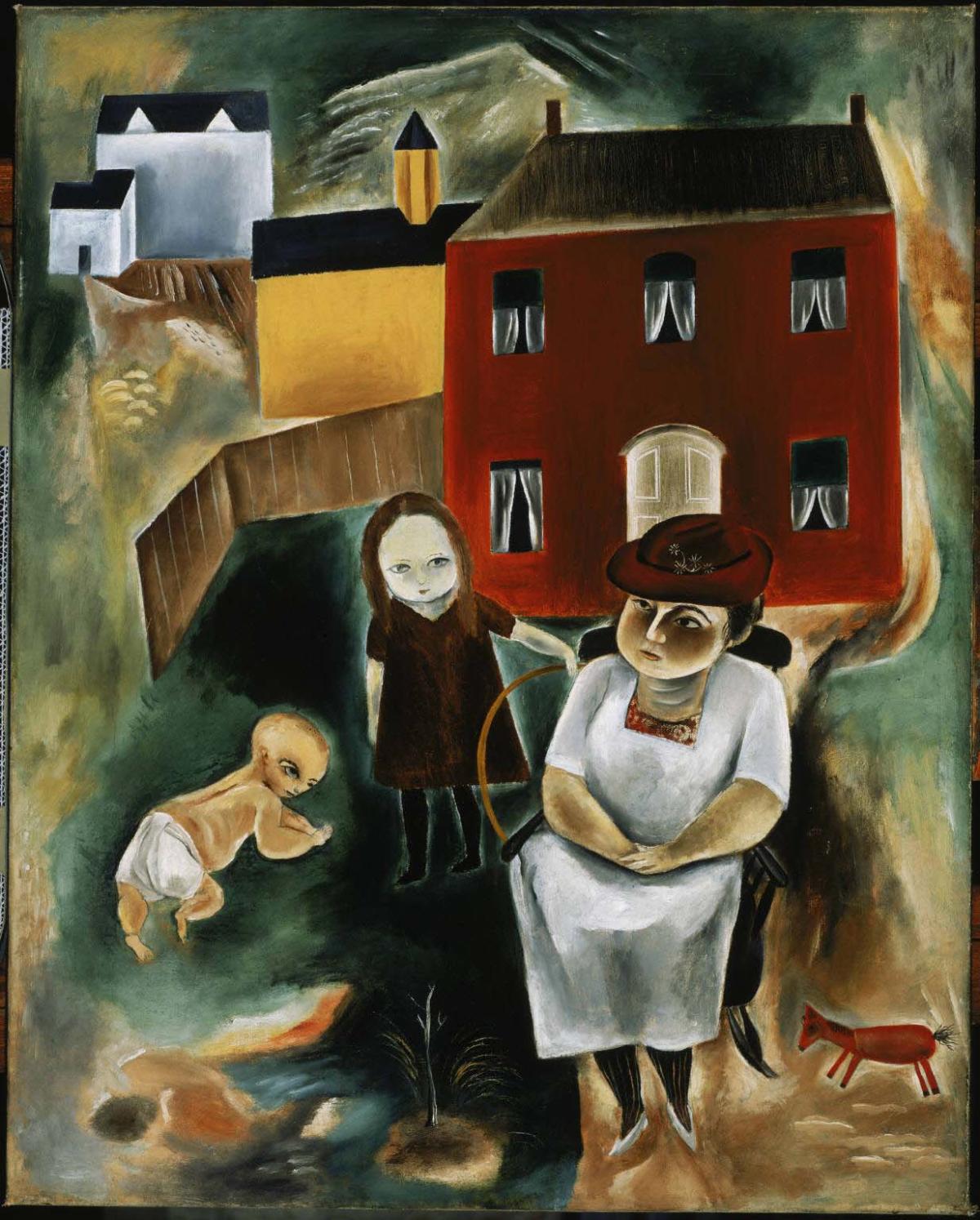Maine Family
Yasuo Kuniyoshi ( c. 1922-c. 1923 )

Yasuo Kuniyoshi painted Maine Family during one of the summers he spent at an artists’ colony in Ogunquit, Maine, in the 1920s. An early work, it reflects the simultaneous influences of both the Western modernist idioms and his Japanese artistic heritage. Its distortions of scale and perspective resemble a child’s depiction of family members in front of their house. However, the curious omission of a man from the group, along with the juxtaposition of the formally attired lady, the diaper-clad baby, and the otherworldly quality of the little girl, which is likely inspired by memory portraits in nineteenth-century American folk art, add to the unconventional air. Certainly the folk art influence, as well as naive styles in modern painting, like those of Henri Rousseau, Marc Chagall, and Heinrich Campendonk, can be detected in Kuniyoshi’s handling of the composition and details in Maine Family.
Simplified rectangles and triangles of color define the background buildings and reflect the artist’s exposure to Cubist painting. In contrast, the figures, which are angular and possess Kuniyoshi’s characteristic almond-shaped eyes and unnaturally pointed feet, are given bodies that exist as three-dimensional entities in space.
In 1928, twelve years before Duncan Phillips acquired Maine Family, his first work by the artist, he recognized Kuniyoshi as a serious painter who beautifully combined Japanese and American artistic tendencies. He admired the artist’s “confident calligraphy … stylistic brush writing … [and] arbitrary color chord of ivory and ebony and lacquer red,” which appeared throughout Kuniyoshi’s oeuvre, as well as the “plasticity” and “vital” evocation of “the inner truth” that Phillips believed he had acquired from Western art. To Phillips, Kuniyoshi’s painting represented a “new idiom of quaint pictorial expression.”
Yasuo Kuniyoshi painted Maine Family during one of the summers he spent at an artists’ colony in Ogunquit, Maine, in the 1920s. An early work, it reflects the simultaneous influences of both the Western modernist idioms and his Japanese artistic heritage. Its distortions of scale and perspective resemble a child's depiction of family members in front of their house. However, the curious omission of a man from the group, along with the juxtaposition of the formally attired lady, the diaper-clad baby, and the otherworldly quality of the little girl, which is likely inspired by memory portraits in nineteenth-century American folk art, add to the unconventional air. Certainly the folk art influence, as well as naive styles in modern painting, like those of Henri Rousseau, Marc Chagall, and Heinrich Campendonk, can be detected in Kuniyoshi's handling of the composition and details in Maine Family.
Simplified rectangles and triangles of color define the background buildings and reflect the artist’s exposure to Cubist painting. In contrast, the figures, which are angular and possess Kuniyoshi’s characteristic almond-shaped eyes and unnaturally pointed feet, are given bodies that exist as three-dimensional entities in space.
In 1928, twelve years before Duncan Phillips acquired Maine Family, his first work by the artist, he recognized Kuniyoshi as a serious painter who beautifully combined Japanese and American artistic tendencies. He admired the artist's "confident calligraphy . . . stylistic brush writing . . . [and] arbitrary color chord of ivory and ebony and lacquer red," which appeared throughout Kuniyoshi's oeuvre, as well as the "plasticity" and "vital" evocation of "the inner truth" that Phillips believed he had acquired from Western art. To Phillips, Kuniyoshi's painting represented a "new idiom of quaint pictorial expression."